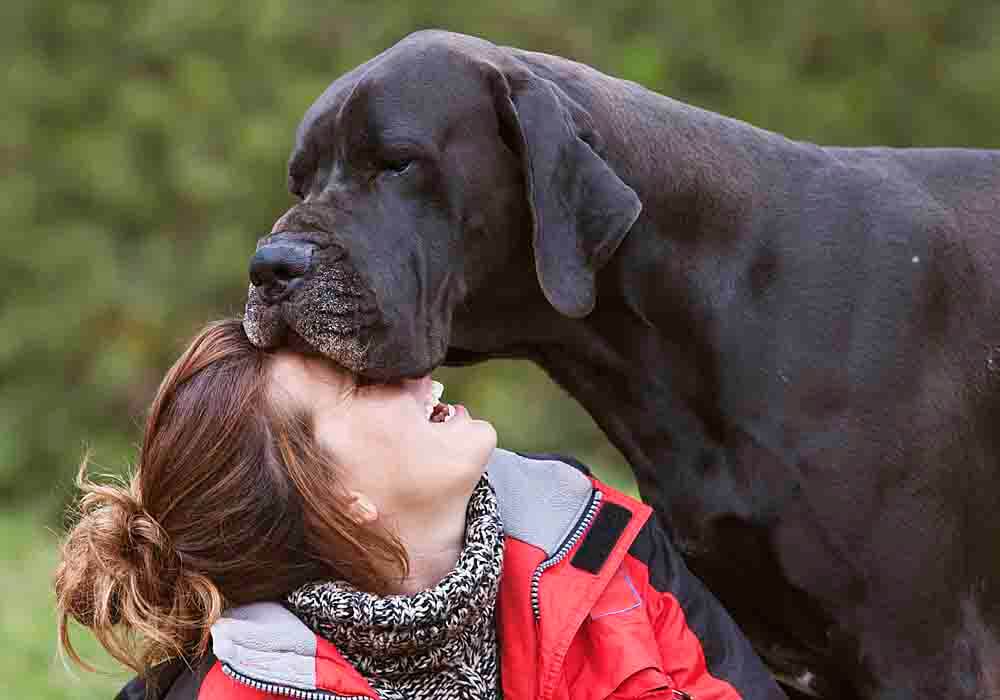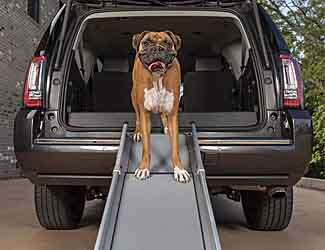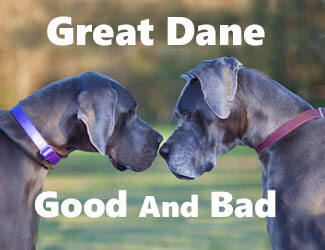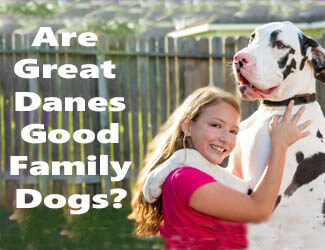Great
Dane Dog Breed Information
History, Personality, Health and Traits
by Ken Alden
If you're interested in learning more about the Great Dane dog breed or are considering acquiring one as a pet we think you'll find this page enlightening on both fronts.
What’s it like to own a Great Dane? Owning this breed requires a bit of patience because these dogs can knock over chairs and children even as puppies. While they are large dogs that can weigh up to 180 pounds or so, they have big hearts. So, if you want a large dog breed that’s a lover and not a fighter, then this might be the perfect breed for you.
Since
there isn’t a lot of information available on the Internet today about this breed, we created this guide to help save you hours on your research. Below
we’ll cover some information about this dog, including an overview of the
breed, history, information about their personality, and information about
their health needs. Read More Below...
Pro-tip: Ever try lifting a Great Dane? Their weight can hurt not only your back but their joints when they hop down from cars, sofas or even your bed. To protect your back and theirs check out the best Mastiff ramps on Amazon.com now.
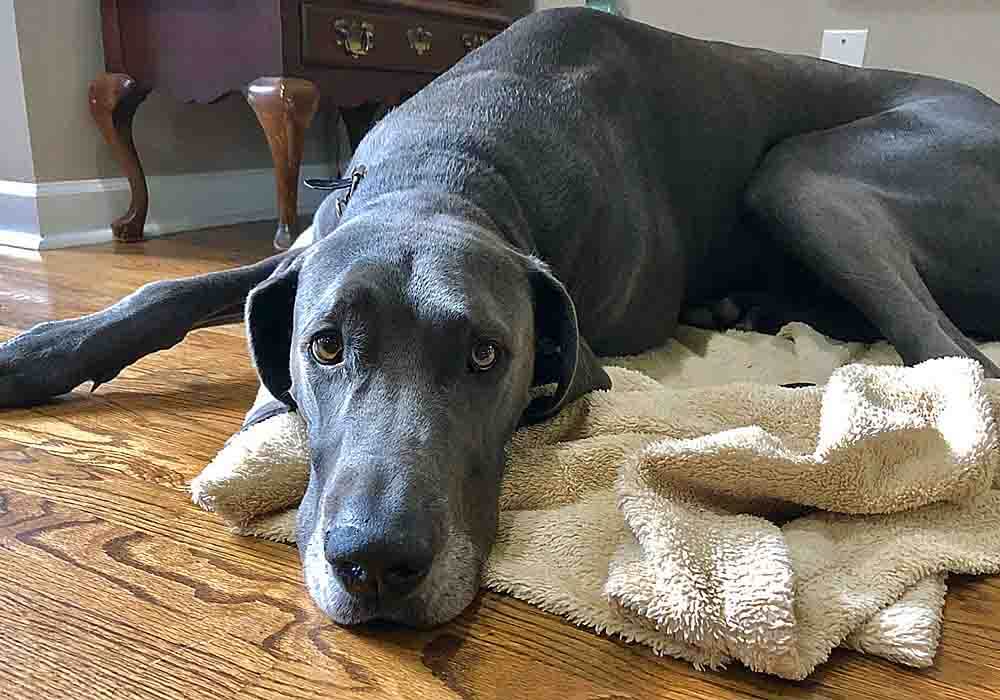
Overview of the Great Dane Breed
If you’re the type of person that’s not intimidated by the size of the dog, and you enjoy broad, sweet canine pets, then this breed would make an excellent dog for you. While this dog breed was initially bred to take down dangerous boars and protect people’s mansions, nowadays, these dogs are better off as pets. Owning a Great Dane is comparable to owning a gentle giant, making this a unique dog breed to pick.
While these dogs are some of the most massive dogs you’ll probably ever see in your life, the fact that these dogs are so calm means they don’t do badly even when they live in apartments. This dog not overly anxious or active as a breed. Puppyhood might be challenging to get through if you live in an apartment, but once your dog is socialized and trained, these dogs will do just fine with one good twenty minute walk every day for some exercise.
Also, if you’re looking for a beautiful guard dog, they do make excellent protectors. Danes are well-known to be protective when it comes to their families. So, if you own one, you will need to take extra care to ensure your dog doesn’t jump on people, nip, or perform any act of aggression. While nibbles can be laughed at when we are dealing with small dogs, with these dogs, you’ll have to be careful.
If you wind up owning one, you’ll also learn that people that aren’t familiar with your Great Dane will probably be intimidated by its size. That’s fine, but that’s another reason why you don’t want this kind of dog to jump up at people and nip or nibble at them, even if it’s a game to the dog. Chances are, with a dog so large, somebody could wind up getting hurt.
So,
keep in mind that it takes a special kind of person with the right personality
to own this breed. You’ll need to be very attentive to your dog when it’s
very young, and make sure you are a responsible owner that teaches the dog good
manners. If you are willing to invest the necessary amount of time and effort
into this dog, you’ll wind up with one magnificent animal.
Pro-tip: Great Dane anxiety, aggression, destructive chewing, jumping up, fearfulness, and other behaviors can be controlled with the right training program.
Here’s a great course that
addresses these issues along with many other dog training basics: Check it out now!
Great Dane History
Some people mistakenly believe that the Great Danes started in Denmark. However, that assumption is incorrect. This breed known as “German Mastiffs” and originate in Germany. Many feel this dog is a combination of a few more substantial breeds, like the Irish Wolfhound, who probably gives this dog its height, the Bull Mastiff, who gives this dog its bulk, and the Greyhound, who helped give it the sleek look.
Great Danes were initially bred to hunt wild boar. When they were first produced, they were made to be as aggressive as the wild boars they were bred to hunt. When this trend faded, you’d often see these large dogs acting as estate or mansion protectors.
Back in 1876, the Great Dane earned the title of the national dog of Germany. This dog has been called “the Apollo of dogs” because of its size. The dog breed has been around for about 400 years or so and became the popular estate guardian of 18th century Germany. Many who were upper class and living in Germany at the time felt also used these dogs for sport because they could chase boar.
In the 1800s, the Great Dane, as we know it today, started being bred to become the gentle giant we have now. Also, at the same time, Germans banned the use of the term “Great Dane” and started calling the breed “Deutsche Dogge,” which translates as German Mastiff. However, in English-speaking countries, the name “Great Dane” stuck and is still used.
However, this breed didn’t remain only accessible in Germany, but they started to be
sought out in other parts of the world, too, including the United States.
Nowadays, you’ll find them listed as the 17th most popular dog breed
registered through the American Kennel Club. If you compare those standings to
this breeds previous standings, then you can see a rise in popularity for
this dog. Back in 2000, the Great Dane was the 28th most registered dog.
We’ve
seen a rise in popularity over the years because they have evolved into
gentle giants. They are protective and intimidating, but they are also sweet
and kind pets. Many owners feel that Great Danes are the perfect type of dog to
own as long as you train them effectively early on. They make excellent
family pets, make great apartment dogs despite their large size, and do a great
job of protecting your home against robbers.
Great Dane Traits
Danes are not the type of dog breed that is naturally a nuisance barker, like a chihuahua, for instance. However, if you aren’t responsible for your Great Dane as an owner, they can develop a habit for barking. We highly recommend you stay on top of your dog’s training and that you don’t allow for that barking habit to ever develop. That’s because these dogs have the loudest, most booming bark of any dog breed, and they can be heard for miles sometimes.
For example, if you ever saw the movie “101 Dalmatians,” you’ll remember that the Great Dane was the leader of the Twilight Bark when it tried to find information about the missing puppies. Disney wasn’t joking around with you when they depicted that dog’s ability to bark in the movie. That’s why we recommend breaking any barking habits early on.
Some owners of this breed like to have their dog’s ears cropped. However, that trend seems to be dropping in popularity lately. We don’t even see cropped ears on Great Danes much in the show ring anymore. Some people feel this cosmetic procedure is a must, but in reality, cropping your dog’s ears doesn’t benefit the dog in any way. It’s excruciating for a dog to undergo an ear cropping surgery, so many owners don’t partake in that anymore.
When it comes to grooming, you won’t have to worry too much about doing anything special. They have very short coats that do require maintenance, but that maintenance is relatively low. Since this dog does shed and they are large dogs, it will still feel to you that you’re dealing with a lot of hair around your house.
So,
while you won’t have expensive grooming bills, if you adopt a Great Dane, you
will have to consider how much it will cost to feed this beast of a dog. Since
these dogs are so large, they do need a lot to eat, and that’s especially true
when they are growing puppies. You never want to overfeed any dog, but it’s
something you need to avoid with this dog as a puppy. If a Dane puppy
grows too quickly, it can develop skeletal issues, including arthritis.
The Great Dane Personality
While we’ve mentioned a bit already about the Great Dane’s personality, we haven’t covered all of the details yet. So, we wanted to dedicate this section to this large dog’s unique personality, because many owners of this breed feel that its temperament is one of the best things about owning this dog.
You’ve already heard us mention that this dog is a gentle giant when it comes to personality. However, they are naturally protective dogs, especially when it comes to their family and loved ones. This large dog breed is extremely affectionate and adores attention from humans. Since these are naturally sweet, large dogs, you never want to encourage aggressive behavior in such a large pooch.
Because this dog has such a sweet nature, they are outstanding when they are around children. They love children, but you do need to train them to be gentle and careful around kids. Once you teach your dog how to act around children, you’ll always have to supervise your pal around kids, but your dog will get the hang of being gentle.
Great
Danes are not only good pets because they do well around children, but they
also do well with other pets. They are great at learning how to handle
other pets well, and they do very well when they are raised with the other pets.

You'll love this other helpful article of ours dedicated to all there is to know about the personality and temperament of Great Danes.
Pro-tip: Great Dane's (and their owners) love dog crates…and for good reasons. Crates keep dogs from mischief while you're away, are perfect for house training, for traveling by car, and provide the dog a place to de-stress. Check out the best Mastiff crates on Amazon.com now.
Yards for Great Danes
It’s a good idea to have a yard when you own this large of a dog. You’ll have to make sure you’ve fenced your yard appropriately so that your dog doesn’t wind up escaping. Luckily, they aren’t jumping dogs, nor do they like to scale walls like Beagles. With a Great Dane, you should be okay with a six-foot fence or so to keep your dog in. Remember that adults of this breed are laid back, lazy dogs, puppies are very high-energy, and they can dig as puppies.
Some people naturally assume that they should live outside their whole lives because of their large sizes. However, when it comes to a Great Dane, the opposite is really where the truth lies. Your pooch needs to be an indoor dog who feels like he is a member of the family to thrive. When families adopt these dogs and keep them indoors, they wind up with a loving, patient dog that is willing to learn.
So, treating a Dane correctly by allowing him to stay indoors and act as a member of the family means you’ll have a dog that will be easy to housetrain, socialize, and train. However, if you leave a Great Dane outside all the time alone, it can be very destructive if you aren’t treating it right. If you allow your dog to develop any form of separation anxiety, it can do a lot of damage to home and yard.
Avoiding Bad Habits...
All dog breeds, when mistreated, can wind up with horrible habits like barking, digging, and even counter surfing when you allow your pup to get bored, if you haven’t trained it correctly, or if you leave it unsupervised often. So, when it comes to bad habits, Great Danes don’t vary much from most other dogs. Any dog can be challenging to live with when it’s a puppy, and especially an adolescent.
For this breed, you’ll hit the teenage years with them when they are about six months old. The dogs will age out of their adolescent years when they get to two years old. It’s best to make sure you start off owning your Great Dane with the idea of avoiding bad habits in mind. So, you should start training your pup as soon as you get it back to your house. Even when your pup is as young as eight weeks old, they can start learning.
It’s much easier to avoid bad habits with a dog than it is to break a dog’s bad habits. So, never wait until your dog is six months old or any age to start training it, or you’ll wind up with some bad habits to break. Breaking bad habits with a dog like this can take substantially longer than merely avoiding the bad habits in the first place. So, start teaching your dog right away and make sure you socialize your dog as well.
If
you’re thinking about taking your dog to a puppy training class, your pooch will need to have certain vaccines. Also, depending on how young your dog
is, you’ll have to limit some exposure to dogs and people until you’ve done all
of your puppy shots. So, you may not be able to hit the formal training classes
immediately, but that still means you should be making attempts to train and
socialize your dog with friends and family while at home, and until your puppy
has all
of its shots.
Great Dane Health Issues
Now that you understand a bit about this dogs personality, we’ll cover what you can expect when it comes to a Great Dane’s health. Keep in mind that every dog breed can experience its variety of genetic health issues, just as some people are more likely to inherit a particular disease when compared to another.
When you are searching around for a Great Dane breeder, never purchase a puppy from a breeder that won’t give you a health guarantee on their puppies, who tells you that this breed is healthy and has no known problems, or who says her puppies are isolated for health reasons.
Remember that reputable breeders are honest and open about the variety of health problems this breed experiences, and how many times this happens in her lines. Reliable breeders will inform you that this dog can experience several health problems and go over those issues with you because they’ll care about where their puppies will eventually be going. A good breeder will want to ensure you are ready to handle this large dog breed.
So, what are some of the more common health problems we see in this breed? One condition that Great Danes often experience is called bloat. Bloat is when the stomach expands and gets full of air. If the problem happens frequently, it can become serious and create gastric torsion. That happens when the dogs stomach twists over on itself and cuts off the dog’s blood supply.
Cardiomyopathy
Another
health condition they experience often is cardiomyopathy, which is a
disease that affects the heart muscle and creates an enlarged heart. In most
giant dog breeds, cardiomyopathy is very common, and Great Danes are no
exception. When this dog experiences this issue later in life, you can
typically take care of it with proper medication.
Another condition that many large dog breeds suffer from, hip dysplasia, also affects this dog. Hip dysplasia is a malformation in the hip socket area that can require expensive surgery to fix.
Cancer
When
it comes to Great Danes, cancer is another leading cause of death. Bone cancer
is the major issue with this breed. Unfortunately, when it comes to pets, it’s
challenging to screen for cancer to make any accurate predictions. Also, since
cancer is sometimes genetic and sometimes not, asking the breeder about cancer
in relatives may not help you out as much as you think.

Learn even more about the health issues Great Danes are most prone to in this helpful article of ours.
Great Dane...Final Thoughts
If you are considering acquiring a Great Dane, then you’ll want to make sure you are the right kind of person for this breed of dog. As long as you are willing to spend the time and effort to train your pooch as soon as you bring it home, you should wind up with a well-behaved dog.

About the Author...
Ken Alden, a dedicated Mastiff owner for over eight years, is acclaimed for his expertise in care, grooming, and training. Read more About Me and my dog Shadow.
- Mastiff Guide Home ›
- Mastiff Breeds ›
- Great Dane Information
